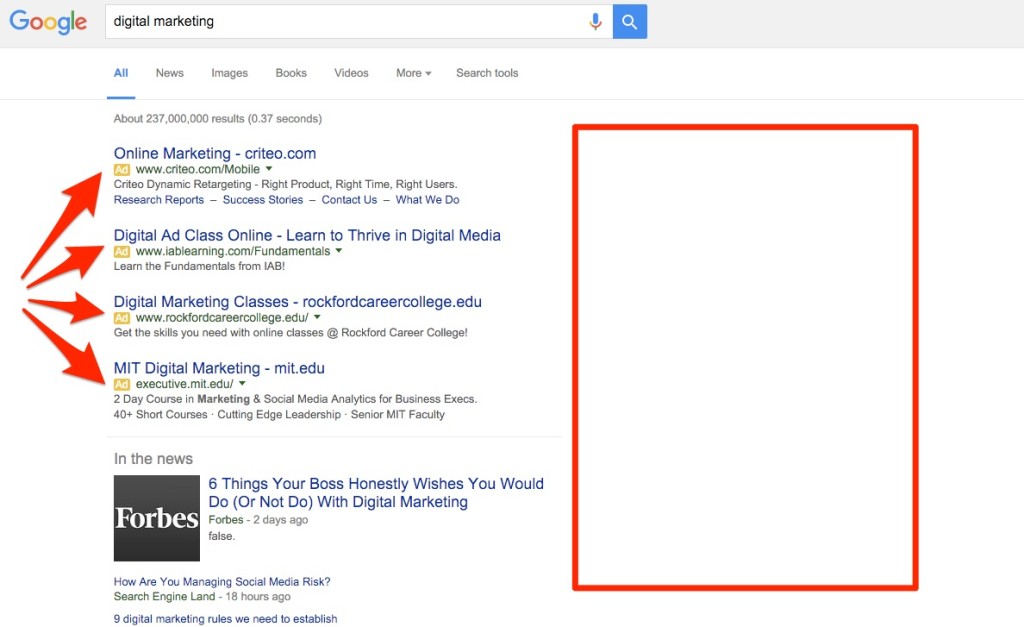Google Drops Sidebar Ads: Full Summary of Impact for SEO
The rumors are true: Google has dropped sidebar ads on their SERPs. Marketers have been watching what appeared to be some testing of the new format for a couple of weeks now. Last week, The Media Image broke the story, and a Google spokesperson confirmed the changes with Search Engine Land the next day. Earlier this week, the rollout was complete.
The SEO/SEM lunch table has been abuzz with speculation, but let’s get right down to what this means for marketers—and especially SEO.
What Does This Mean for SERPs?
Exact results may vary, depending on how “commercial” Google deems the search, but changes include:
- No sidebar ads. Ever. The right column is now exclusive to Knowledge Graph panels and product list blocks.
- Up to four text ads at the top. The ad block at the top previously maxed out at three, but Google confirmed that, for “highly commercial” search queries, a fourth may now appear. (Although Dr. Peter J. Meyers points out, on The Moz Blog, that a fourth ad is showing for some very not-commercial keyword phrases.)
- Up to three text ads at the bottom of SERPs. That’s a grand total of only seven ads per SERP—down from a possible 11 when Google was displaying sidebar ads.

It’s ironic-bordering-on-hypocritical that Google is filling up their own pages, namely the tops of those pages, with ads—something they consistently tell publishers not to do. Focus on quality, they tell us. Don’t push ads, they tell us. But when you’ve got the monopoly on search, you do what you want.

Is SEO Finally Dead?
Despite what some are saying, it’s probably a little premature to declare SEO the “loser” in this situation.
It seems intuitive to say that 4 is the new 1: that the highly coveted #1 organic result is now the #4 paid result, but users are smarter than that and the data just doesn’t support that conclusion.
- Exhibit A: Two years ago, Search Engine Watch posted an article about, “The Evolution of SERPs and User Behaviors.” It demonstrated that hot spots on Google SERPs had travelled down the page over nine years, consistent with the organic results being pushed down by ads and answer boxes.
- Exhibit B: A couple months later, Briggsby posted a synopsis of a Google study that showed, in part, that organic results 2 and 3 get more attention than the #1 organic result on mobile devices.
Why? Because users don’t like ads. Ranking “above the scroll” isn’t as crucial as it perhaps once was, because people know the top of the SERP is ads, so they largely skip it.
In short: no user is going to click on that fourth ad thinking it’s the #1 organic search result. So no, this is not a dark day for SEO.
Does a Fourth Text Ad Affect SEO At All?
The new Google SERPs layout doesn’t have to affect your SEO strategy. If you are still concerned with getting above the scroll (where that’s even possible), the change does highlight some good SEO strategy you should already be doing—but probably aren’t.
- Get scraped into Answer Boxes—The only chance marketers have of getting organic results above the fold on “highly commercial” searches is to show up in that answer box. Some are still uneasy about Google “stealing” content, but it might be the price we pay to be on top. Create clear, concise definition statements and position them at the top of your content to provide good material for the answer box.
- Target long-tail keywords—Create evergreen content that answers your audience’s questions. A search for “LTL shipping,” for example, displays four ads and an answer box, pushing all the organic content below the scroll. A search for “what is LTL,” however, serves zero ads on the SERP.
- Clean up your Knowledge Graph panel—Does a branded search display a Knowledge Graph panel for your brand? Is it accurate and appealing? Make sure you know how to change what Google displays about your brand.
What Does This Mean for SEM?
There’s debate on what this will do to CPC rates. The Media Image suggested that the overall decrease in the number of available ad spots would drive up CPC and ad clicks:
One potential reason for limiting the amount of advertisers on the SERP might be that Google has determined the average CTR for the RHS ads is poor across verticals, and the expected CPC inflation from this major change is projected to more profitable in the long run, we suspect.—The Media Image
Other search engine marketers argue that an extra ad spot at the top of the SERP might have the opposite effect:
There are more top slots now. That alone would mean lower prices for the top. This part is much more certain than the demand side #ppcchat
— Martin Roettgerding (@bloomarty) February 22, 2016
I would probably throw my hat in with the first camp, and wager that Google’s ad spots are about to get a price hike, but only time will tell for sure. Either way—whether this turns into higher prices or more competition for the best ad spots—it might actually be search marketers who have their work cut out for them.
Why Did Google Drop the Sidebar Ads?
We don’t really know why Google decided to drop the sidebar ads. Maybe The Media Image is right, and it’s about inflating CPC prices. Maybe it was to reserve the space for product ad panels and/or the ever-expanding Knowledge Graph panels. Maybe, as Dr. Meyers suggested on The Moz Blog, it’s to standardize the search experience across mobile and desktop devices.
No one knows for sure, and it doesn’t really matter. At the end of the day, Google can, and still does, get away with almost anything.
What's Next?
Profound Strategy is on a mission to help growth-minded marketers turn SEO back into a source of predictable, reliable, scalable business results.
Start winning in organic search and turn SEO into your most efficient marketing channel. Subscribe to updates and join the 6,000+ marketing executives and founders that are changing the way they do SEO:
And dig deeper with some of our best content, such as The CMO’s Guide to Modern SEO, Technical SEO: A Decision Maker’s Guide, and A Modern Framework for SEO Work that Matters.




